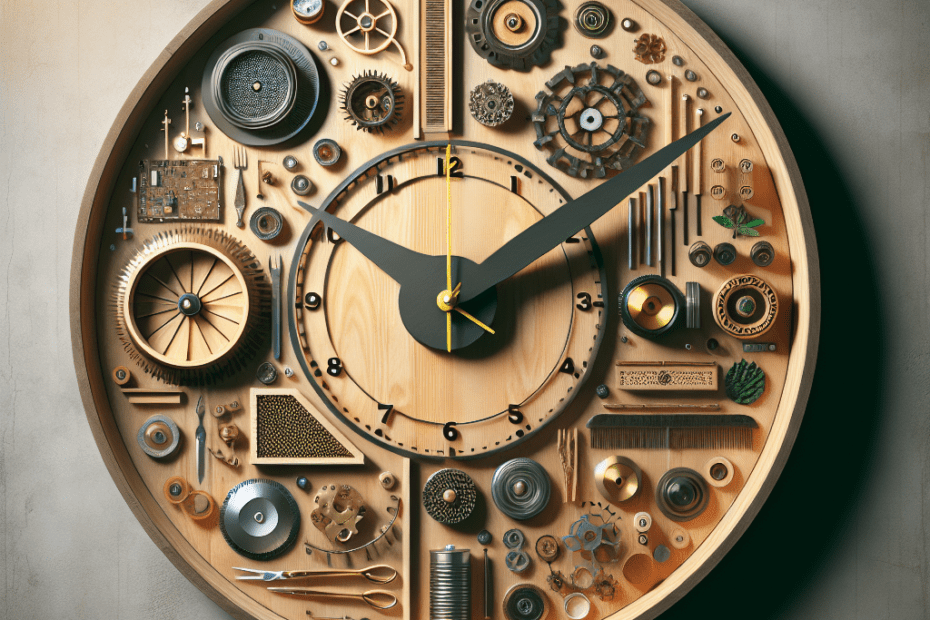“`html
DIY Wall Clocks from Repurposed Materials: A Creative Journey
In an era where sustainability and creativity are flourishing, many people have embraced the art of creating DIY wall clocks using repurposed materials. This trend not only allows them to add a personal touch to their homes but also supports environmental conservation by reusing materials that would otherwise end up in landfills.
The DIY movement has grown significantly, with statistics showing that about 72% of Americans have attempted at least one DIY project (Source: Statista). This trend can be seen in the increasing popularity of DIY wall clocks made from recycled materials like wood, metal, and even plastic. These projects are perfect for those who love crafting and wish to make unique timepieces.
Why Create a DIY Wall Clock?
There are several reasons people might choose to create their own wall clocks:
- Cost-Effectiveness: Creating a wall clock from repurposed materials can be significantly cheaper than purchasing one from a store. They can often find the necessary components at home or at thrift shops.
- Eco-Friendly: By using materials that would otherwise be discarded, they are contributing to a more sustainable environment.
- Customization: DIY wall clocks offer the opportunity for infinite customization, allowing creators to design a clock that perfectly matches their decor and personal style.
- Skill Development: Engaging in such projects helps improve crafting skills, fostering a sense of accomplishment.
Materials to Consider
When gathering materials for a DIY wall clock, individuals have a plethora of options to choose from. Some popular choices include:
| Material | Source |
|---|---|
| Wood | Old furniture, pallets, or even driftwood |
| Metal | Discarded tins, wire mesh, or bike gears |
| Plastic | Used bottles, containers, or CDs |
| Fabric | Scraps from previous projects or clothing |
Step-by-Step Guide to Make a DIY Wall Clock
Creating a wall clock by repurposing materials can be a fun and rewarding process. Here’s a simple guide:
- Gather Materials: Select the materials categorized above based on what they have or can acquire.
- Choose a Design: Sketch a design of how they want the clock to look.
- Prepare the Base: Prepare the main piece where they will attach the clock mechanism. If using wood, they might need to sand and varnish it.
- Attach the Clock Movement Kit: They can purchase these online or from craft stores. Install the mechanism onto the base following the product instructions.
- Add Numbers and Decor: Use paint, stencils, or repurposed items like buttons or stones for the clock numerals or design elements.
- Test the Clock: Insert batteries, set the time, and hang the clock to ensure it functions correctly.
Creative Ideas for Inspiration
For those who may be struggling with ideas, here are some inspirations that others have used effectively:
- Vinyl Record Clock: Utilizing old vinyl records for a retro look.
- Bicycle Wheel Clock: Transforming a leftover bicycle wheel into a modern, industrial-style clock.
- Picture Frame Clock: Arranging multiple small picture frames to replace numeral positions, thus making it a functional gallery wall piece.
- Book Clock: Repurposing an old hardcover book for a literary-themed timepiece.
Key Takeaways
- The DIY wall clock trend supports creativity, sustainability, and cost-saving.
- Repurposing materials not only helps the environment but also adds unique character.
- There are endless possibilities for customizing design to match personal and home aesthetics.
- Even beginners can advance their crafting skills through such projects.
FAQ Section
Q1: What tools do I need to make a DIY wall clock?
A1: Common tools include a screwdriver, pliers, and possibly a drill if they need to make holes in the base material.
Q2: How much does it cost to make a DIY wall clock?
A2: Costs vary, but with repurposed materials, it can be made for as little as $10-20, depending on the necessary purchase of a clock movement kit.
Q3: Can children make a DIY wall clock?
A3: Yes, under adult supervision, children can participate in most of the creative aspects of the project.
Q4: Is it difficult to install the clock movement?
A4: Most clock movement kits come with easy-to-follow instructions, and they can find tutorials online if needed.
Q5: Where can I find inspiration for my clock design?
A5: Inspiration can be drawn from online platforms such as Pinterest, craft blogs, and DIY magazines.
With just a bit of time and creativity, they can transform everyday items into beautiful, functional art. Embracing this DIY wall clock endeavor not only brightens their space but also aligns with a thoughtful and eco-friendly lifestyle.
“`
This blog post guides you through creating DIY wall clocks with an emphasis on sustainability and creativity. It includes a guide, material ideas, and a FAQ section, all while ensuring it is engaging and informative.
